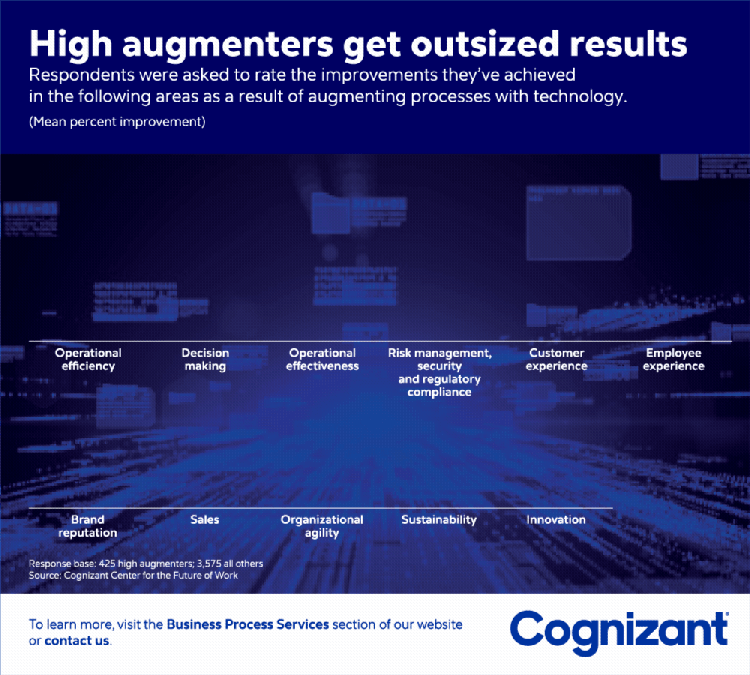
Critical components of an intelligent automation strategy styles-h2 text-white
data-xy-axis-lg:null; data-xy-axis-md:null; data-xy-axis-sm:20% 40%
<p><span class="medium"><br>February 23, 2022</span></p>
Critical components of an intelligent automation strategy
<p><b>Digitizing a process needn’t start as a radical, invasive undertaking; we offer a checklist for organizations undertaking process change.</b></p>
<p>Businesses are in a time of great — and unanticipated — change. For the past several years, whether it was through analytics, artificial intelligence (AI), robotic process automation (RPA) or work-from-home capabilities, companies were already shifting quickly into new ways of getting process work done.</p> <p>Then, in the wake of the prolonged pandemic, immediate priorities (e.g., “Everything that can go online, must go online!”) necessitated business interactions and transactions to be more connected, more simple — more “human.” Operating a business in these times of contagion has thrown into sharp relief the importance of establishing digital value chains between employees, partners, customers and suppliers that allow process work to happen effortlessly, flowing around any obstacles that get in the way and gaining intelligence over time.</p> <p>The great challenge now is to hyperscale this type of “being digital” to the scores of processes that rely on the uber-critical systems, applications and operations at the heart of most big businesses — from processing insurance claims, to approving mortgages, to caring for patients, to growing personal wealth, to ordering a utility or new streaming service. As the following figure illustrates, the payoff for process augmentation is significant.</p>

#
<p><br> Offering frictionless processes is now a critical competitive necessity. It’s become unsustainable for organizations to maintain expensive and sclerotic legacy silos, where antiquated approaches cause clunky, flawed, frustrating experiences.</p> <p>Going forward, businesses need to rethink how work gets done so that the starts, stops, handoffs and run-arounds are eliminated (or at least made virtually unseen) for those interacting with them. In doing so, the notion of a “process” needs to be rewired into dynamic, fluid, always evolving, scalable, predictable and proactive human experiences that employees, partners and customers value most. (For an extended discussion of this topic, see our white paper, “<a href="/content/dam/connectedassets/cognizant-global-marketing/marketing-channels/cognizant-dotcom/en_us/insights/documents/how-digitally-modern-processes-make-great-experiences-codex6923.pdf" target="_blank" rel="noopener noreferrer">How Digitally Modern Processes Make Great Experiences</a>.”)</p> <h4>Taking on the challenge</h4> <p>The necessity of process digitization is inarguable. However, in our experience, many businesses flail when facing the need to do so — or to do so at scale.</p> <p>To get started, we recommend that organizations incorporate the following into their intelligent automation strategies:</p> <ul> <li><b>Map the customer journey and modernize how the business delivers.</b> While it’s a good first step to do the hard yards of process-by-process change with established practices like process mining, the real journey is to digitally change the DNA of work and work processes that sprawl across disparate business units. Now is the time to map customer journeys and evaluate every process to deliver the best experience and optimize people, processes and technology to remove every friction point possible.<br> <br> </li> <li><b>Write off “experience debt” by humanizing and connecting workflows. </b>For digital processes to really change an organization, companies need to create vastly more humanized transactions and experiences. That means taking the time to really observe customers, partners, suppliers and employees — their motivations, their pain points, their frustrations and experiences with the organization’s products and services.<br> <br> </li> <li><b>Optimize the workforce for a new way of work.</b> Free employees from the tyranny of the tedious by augmenting them with technology to unleash their full potential and business value. The people, talent and structure behind intelligent process automation (IPA) is as important as the technology, so involve employees in the journey and allow them to experience firsthand the benefits of a new way of working, which in turn accelerates IPA adoption. Look for highly repetitive tasks occurring at great scale within the organization, like processing an invoice, proofreading documentation, “picking and packing,” reconciling, etc.<br> <br> </li> <li><b>Orchestrate IPA at scale.</b> To realize the full benefits of automation, it is vital not only to create a roadmap for automating processes across the enterprise but also, in some cases, to integrate isolated processes. The first step is a complete process audit to understand which processes make the most sense to fix, which should be left alone and which can be eliminated. Doing so can eliminate bottlenecks, manual handoffs and siloed data. This is particularly true when connecting customer-facing processes to back-end operations.<br> <br> </li> <li><b>Prioritize data — it’s the real process prize.</b> Look for areas in which processes and workflows can be digitally instrumented via mobile platforms, sensors, telematics and IoT, where processes are “born automated” and from which transaction data, previously unavailable, can be generated and managed. The delivery of clean, believable, real-time insights into operations is the real prize of digital process initiatives.<br> <br> </li> <li><b>Relying on internal capabilities alone won’t be an option for most.</b> Most businesses will need partners to help design, build, deliver, scale and curate ideas based on processes, newly invented digital tools or developments in wearables, sensors and 3D printing, let alone the latest in process mining approaches, data ingestion, analytics, machine learning, etc. That’s where service providers that deliver outcomes (over transactions) are critical.</li> </ul> <p>When organizations understand “how the knee bone is connected to the hip bone” in their extended processes and value chains, good things can happen. If you change the work process, you can change the business process, which in turn allows operating models to modernize in support of executing on the corporate strategy — not obsessing over the number of people “doing the process.”</p> <p>Armed with new and powerful levers to create real process change, there’s nowhere to hide in the dark corners of the back office anymore. Through targeted approaches and a thorough understanding of how processes interconnect and interact, businesses can use digital technologies to remove the rocks and roots of older legacy approaches and enable processes to flow smoothly into the calm waters of experiences.</p> <p><i>To learn more, read our white paper “</i><a href="/content/dam/connectedassets/cognizant-global-marketing/marketing-channels/cognizant-dotcom/en_us/insights/documents/how-digitally-modern-processes-make-great-experiences-codex6923.pdf" target="_blank" rel="noopener noreferrer"><i>How Digitally Modern Processes Make Great Experiences</i></a><i>,” visit the </i><a href="https://www.cognizant.com/us/en/services/business-process-services" target="_blank" rel="noopener noreferrer"><i>Business Process Services</i></a><i> section of our website or </i><a href="/content/cognizant-dot-com/us/en/about-cognizant/contact-us.html" target="_blank" rel="noopener noreferrer"><i>contact us</i></a><i>.</i></p>
<p>We’re here to offer you practical and unique solutions to today’s most pressing technology challenges. Across industries and markets, get inspired today for success tomorrow.</p>
